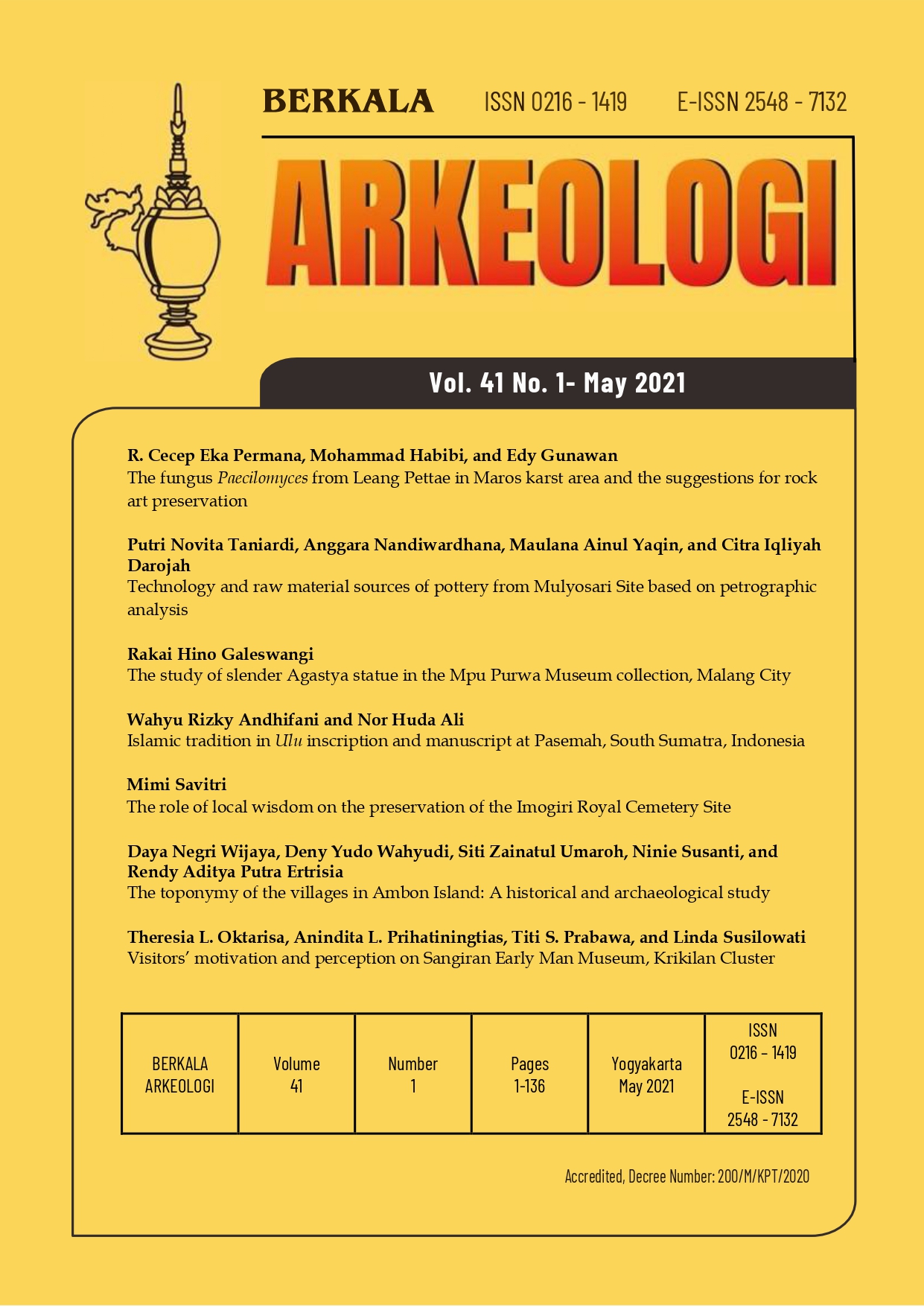Islamic tradition in Ulu inscription and manuscript at Pasemah, South Sumatra, Indonesia Tradisi Islam dalam prasasti dan naskah Ulu di wilayah Pasemah, Sumatera Selatan, Indonesia
Main Article Content
Abstract
Ulu is a script developed in the southern part of Sumatra. The origin of the word ulu interpreted as upstream of a river or a highland. Ulu scripts are no longer used in the present era. Nevertheless, this paper examines the Islamic tradition in the Pasemah area based on the contents of Ulu manuscripts and inscriptions. The research objective is to discover the Islamic tradition in the contents, while the research purpose is to identify the influence of Islamic tradition towards the content. The research method includes data processing (source study, interview, and literature study), description of scale, origin, owner, state or condition, language, variation of characters, transliteration, translation, interpretation, synthesis, and data presentation. The result shows that the contents of Ulu manuscripts and inscriptions have intensely been influenced by Islamic tradition. The influence of Islam in Ulu manuscripts or inscriptions can also be comprehended from the public opinion towards it, categorized as profane, semi-sacred, and sacred.
Article Details

This work is licensed under a Creative Commons Attribution-NonCommercial-ShareAlike 4.0 International License.
References
Alam, S. (1994). Huruf Ulu aset yang terlupakan. Jurnal Aksara Balaputera Dewa, 4, 4–6.
Andhifani, W. R. (2017). Naskah dan prasasti beraksara Ulu. In 25 Tahun Retrospeksi Balai Arkeologi Sumatra Selatan (hal. 175–191). Kepel Press. http://katalog.kemdikbud.go.id/index.php?p=show_detail&id=466605
Andhifani, W. R. (2018). Identitas masyarakat Sumatra Selatan: kajian epigrafis atas unsur-unsur keislaman pada prasasti Ulu. Universitas Islam Negeri Raden Fatah.
Andhifani, W. R. (2019). Laporan penelitian arkeologi tradisi Islam dalam isi prasasti dan naskah Ulu di wilayah Pasemah.
Arios, R. L. (2019). Pertukaran sosial dalam tradisi Pantawan Bunting pada suku bangsa Besemah di Kota Pagaralam, Provinsi Sumatera Selatan. Patanjala, 11(3), 467–482. https://doi.org/10.30959/patanjala.v11i3.537
Ikram, A. (2015). Inscribing identity: The development of Indonesian writing systems. The National Museum of Indonesia.
Indriastuti, K., Siregar, S. M., Purwanti, R., Fahrozi, M. N., Novita, A., Wiyana, B., Andhifani, W. R., Amilda, N., Irwanto, D., Rudito, B., & Saharuddin, N. (2016). Peradaban masa lalu Sumatera Selatan (B. B. Utomo (ed.)). Balai Arkeologi Palembang. http://repositori.kemdikbud.go.id/id/eprint/7287
Irpinsyah, Ali, N. H., & Syawaludin, M. (2019). Mekah kecil di tanah Besemah : studi terhadap dinamika perkembangan Islam di Desa Pardipe Kecamatan Dempo Selatan Kota Pagaralam. Medina-Te: Jurnal Studi Islam, 15(1), 92–107. https://doi.org/10.19109/medinate.v15i1.3248
Jumhari, nfn., & Hariadi, nfn. (2014). Identitas kultural orang Besemah di Kota Pagaralam. Balai Pelestarian Nilai Budaya, Direktorat Jenderal Kebudayaan, Kementerian Pendidikan dan Kebudayaan. http://repositori.kemdikbud.go.id/10278/
Rauf, T. A. (1989). Jagat Besemah Lebar Semende Panjang, Jilid I-II. Pustaka Dzummiroh Yayasan Nurqadim.
Reusen, V. (1992). Perkembangan tradisi dan kebudayaan masyarakat. Tarsito.
Suan, A. B., Eka, P., & Herpansi, Y. (2007). Atung Bungsu: sejarah asal-usul Jagat Besemah. Pesake dan Pemerintah Kota Pagaralam.
Suhadi, M. (1998). Beberapa piagam Kesultanan Palembang. Jurnal Arkeologi Siddhayatra, II(1), 14–26.
Supiyah, Hudaidah, & Susanti, L. R. (2018). Menggali nilai kearifan lokal Suku Basemah melalui kebudayaan guritan. Criksetra: Jurnal Pendidikan Sejarah, 7(2), 46–59. https://doi.org/10.36706/jc.v7i2.6897
Triwurjani, R. (2015). Arca-Arca megalitik Pasemah, Sumatera Selatan: kajian semiotik [Universitas Indonesia]. https://library.ui.ac.id/detail?id=20423683
Yani, Z. (2017). Nilai-nilai keagamaan dalam tradisi lisan Tadut di Kota Pagaralam Sumatera Selatan. Jurnal Penamas, 30(1), 71–84. https://blajakarta.kemenag.go.id/journal/index.php/penamas/article/view/132

